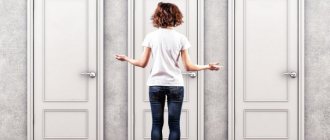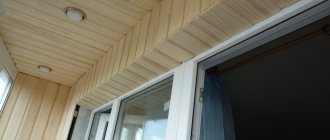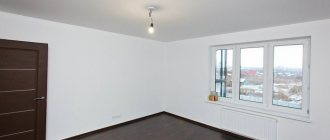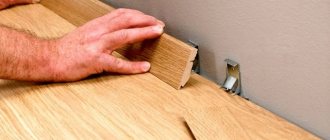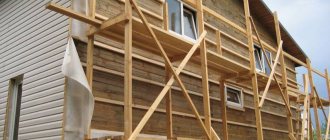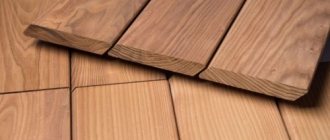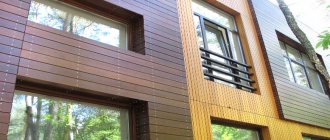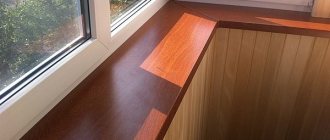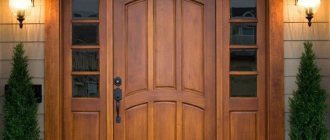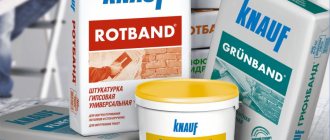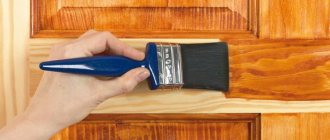Materials used
If you have not yet purchased building materials for finishing, you will have to decide how to finish the door leaf. The materials used for this purpose differ not only in appearance, but also in their characteristics, price, ability to retain heat and silence.
To choose the best option, answer the following questions:
- Door in an apartment or house?
- What is the door to be upholstered made of?
- What are the possibilities?
Lining - natural and beautiful
The entrance door can be finished with clapboard made of larch, spruce or pine.
Advantages of lining:
- moisture resistance;
- are not afraid of cold and temperature changes;
- natural wood looks attractive;
- moderate cost.
To decorate the lining, it is finished:
- varnish;
- carving;
- forging;
- metal or polyurethane moldings;
- beads, rivets, etc.
Laminate - practical and decorative
This is a building material made from fiberboard. It makes an excellent floor covering. This material is glued to the door.
Advantages of laminate:
- big choice;
- presentable appearance;
- no additional decor required;
- simple and quick covering;
- resistance to damage and scratching;
- easy to clean.
Disadvantage of laminates:
- moisture absorption;
- afraid of cold and temperature changes.
Due to the above disadvantages, laminates are used only on apartment entrance doors. In a private home, such a coating is not suitable - the laminate will get wet and quickly deteriorate.
Plywood - cheap and cheerful
Plywood is a layered building material consisting of glued sheets of peeled veneer. In appearance, it imitates solid wood, so it can be used for finishing doors.
Advantages of the material:
- durable;
- tolerates moisture;
- not afraid of temperature changes.
Marine plywood is good, but expensive, so analogues of the following brands are usually used:
- FC. It does not tolerate excess moisture well, but its glue does not contain phenol. It is used only for door upholstery on the reverse side.
- FSF. It can only be used for finishing the outer fabric, since the glue contains toxic substances. But this plywood is not afraid of moisture.
If the plywood is coated with bakelite resin, this makes it difficult to cover the doors. In this case, the places where the glue is applied are sanded in advance.
MDF panels - budget and simple
This budget material is made of wood-fiber boards. It is usually used for interior decoration. In order for the panels to better withstand moisture, they are treated with paint and varnish coatings. MDF is also suitable for finishing entrance doors.
Advantages of MDF:
- simplicity of plating;
- decoration available - painting, filming, etc.;
- durability;
- cheapness.
The disadvantage of MDF panels is their high specific weight. You have to take into account how reliable the door hinges are - if necessary, they are changed. This is why MDF is not suitable for a metal door with hidden hinges.
Fiberboard sheets - durable and easy to clean
Fiberboard or fibreboard is a budget sheet building material. It is used only for finishing apartment doors.
Advantages of fiberboard:
- durability;
- good heat and sound insulation parameters;
- easy care;
- light weight;
- ease of installation;
- price.
The main disadvantages of fiberboard are hygroscopicity and low mechanical strength, which prevent the use of slabs for finishing doors in private homes.
Viniplast - relevant and inexpensive
It is a rigid thermoplastic opaque plastic without plasticizer. Viniplast is created on the basis of perchlorovinyl resin, polyvinyl chloride, thermal and light stabilizers, antioxidants, and pigments.
Advantages of vinyl plastic:
- simplicity of plating;
- excellent thermal insulation properties;
- cheapness.
This polymer material is recommended for cladding metal entrance doors. In order not to spend additional money on finishing, you can use a decorative modification of vinyl plastic.
Leather vinyl - aesthetic and in a wide range
Leather vinyl is a modern analogue of genuine leather. It is not inferior to genuine leather either in appearance or in performance characteristics.
Advantages of leatherette:
- ease of care;
- inertness to dampness;
- soft and pleasant to the touch;
- large selection of shades and textures;
- decorativeness;
- low cost.
Leatherette is suitable for finishing any doors. It is secured with nails, which can be additionally decorated with decorative caps.
The disadvantage of leatherette is its insufficient mechanical strength and instability to aggressive chemicals.
Leatherette - moisture resistant and cheap
This is a dense leather substitute, which is usually used for sewing outerwear and upholstery. It is a universal fabric with a double-sided nitrocellulose coating.
Leatherette was once actively used for finishing doors in entrances, houses, and apartments. Today this material is losing its popularity and is being discontinued.
Advantages of leatherette:
- not afraid of moisture;
- simplicity of plating;
- cheapness.
The disadvantage of leatherette is sensitivity to UV rays, fragility in the cold, fragility, low strength. Under the influence of the sun, the material changes its color and becomes hard.
PVC film - quick and easy
PVC film is a thermoplastic polymer polyvinyl chloride, which is obtained by processing granular polymer material.
Advantages of PVC film:
- quick and simple plating;
- ease of care;
- low price.
The disadvantages of the film are the same as those of leatherette - it is also not strong enough and is not durable. In addition, this material does not allow the recesses to be masked.
Leather - presentable and natural
Leather is a natural material obtained by tanning animal skins. Today it is practically not used for door upholstery - it is expensive and not in trend. Instead of ordinary leather, today they use its analogue - eco-leather.
Advantages of eco-leather:
- flexibility;
- durability;
- presentable;
- good sound and heat insulation properties.
Eco-leather looks and feels no different from natural leather. The downside is insufficient resistance to animal claws.
Powder coating - reliable and expensive
An alternative to mechanical upholstery is powder coating. Typically, such a coating is made in production using special equipment and technologies.
Doing powder coating yourself is extremely difficult. The process involves frying a metal door in ovens to create a uniquely durable coating.
Advantages of powder coating:
- ease of washing;
- corrosion protection;
- high mechanical resistance, including against animal claws.
Powder coating is usually applied in production - during the manufacture of doors. You can do it later, but this is a costly and time-consuming process.
To apply powder coating to a door, you have to go through several steps:
- The door needs to be removed.
- The surface is cleaned of paint, degreased and prepared for processing.
- Send the door into the oven.
As a result, several days pass. This option is not suitable if there is nothing to replace the front door with. Thus, it makes sense to use powder coating only before installing the product.
Sheathing methods inside and outside
Decorative cladding is most relevant for metal doors, which are often installed at the entrance to an apartment or house. Such fabrics are superior to their analogues: their protection indicators and service life are higher. However, cold metal does not always harmonize with the warm colors of the hallway. To make the door look organically in the setting, it is sheathed on the inside. Old wooden, fiberboard and chipboard canvases can also be decorated.
To improve aesthetics, doors are painted, covered with decorative films or covered with leather. The most economical and energy-consuming method seems to be cladding with linings made of plastic, wood, MDF and chipboard. The panels are easy to install, low maintenance, and durable. Many increase the protection and thermal conductivity of the door.
How to choose material?
When choosing a material for door upholstery, first of all, they take into account how suitable this or that option is for self-installation, what tools are available, and whether the owner of the house has experience in finishing work.
How the choice of upholstery depends on the location of the door:
- For cottages and private houses, wood, MDF panels, polymer materials, and ship plywood are suitable.
- For an apartment, in addition to the materials listed, you can use eco-leather, laminate, etc.
Required Tools
After selecting the material, consider the subtleties of its processing. For example, for natural wood panels you will need antiseptic impregnation, varnish or other protective coating. Necessary tools for paneling or slabs:
If products are fixed with an adhesive base, then epoxy glue or liquid nails are recommended. If you need to cut parts, you will need scissors or a hacksaw. To dismantle the fittings, you need a screwdriver and pliers.
Finishing process
Almost any material used to finish the door leaf can be installed independently. To do this, you will need some tools and preliminary preparation of the door surface.
Preparatory work
The outer leaf of the entrance door is prepared for finishing, regardless of the chosen material, according to one scheme.
How to prepare the door:
- Remove it from its hinges. Place it on a flat surface, for example, on stools, to make it convenient to work.
- Remove the fittings from the door - peephole, lock, handles.
- Clean the canvas from dirt, grease, etc. If necessary, wash the surface with detergents - select them taking into account the material. Remove mold and mildew from wood, if any, and rust from metal.
- Apply an antiseptic or moisture-proofing agent to the canvas.
One or two days before the start of work, unroll the finishing material - leatherette, eco-leather, film. This is necessary to smooth out the wrinkles. Naturally, this does not apply to hard materials - slabs, plywood, panels.
Tools
There is no universal set of tools for all finishing options. In each case, you have to select them taking into account the specifics of the work, the door material and upholstery.
In any case, to do door upholstery, you will need a standard set of tools:
- for cutting material - a hacksaw, scissors;
- for measuring - a square and a tape measure;
- for fastening - nails (simple and decorative), self-tapping screws, liquid nails or epoxy glue;
- tool for mechanical fastening - hammer;
- tools for applying paint and varnish - roller and brushes.
This is a basic set, which is supplemented depending on the specifics of the work. Additionally, you will need tools to dismantle the fittings - screwdrivers, pliers. To ensure that all work is carried out accurately and accurately, also prepare a marker or construction pencil.
To speed up the work on door upholstery, professional tools will come in handy, for example, a furniture stapler, a screwdriver or a drill with a special attachment.
Stages of work
The process begins with finishing the ends. They need to be painted - usually they choose paint to match the upholstery material. If the door is supposed to be sheathed on both sides, then the ends are trimmed with strips of upholstery.
Sheathing stages:
- Installation of insulation. It is secured with liquid nails. Or use a furniture stapler. The insulation can be fixed directly to the canvas or to a wooden sheathing.
- Sheathing. After installing the insulating material on the door leaf, upholstery material is installed - lining, panels or other.
- Installation of accessories. Using tools, handles are screwed on and other fittings are installed.
To facilitate the installation process, it is recommended to first mark the nail locations with a marker/pencil.
Cladding
The lining is ideal for upholstery of wood and metal products, entrance and external surfaces. The slats are easy to assemble due to the fact that they are equipped with special grooves.
Wooden
You can cover a wooden door with clapboard yourself and at a minimum cost. The technology is quite simple:
Metal
This process is more complex. Preparation is the same as in the first case. The slats are cut to the required size.
There are two ways to attach them to the door leaf:
The work is completed by sanding the ends, varnishing and then installing the necessary fittings.
Source
Entrance door upholstery technology
The upholstery process depends not only on the upholstery, but also on the door material. Next, we will consider in detail the procedure for finishing wooden and metal panels.
Wooden
The simplest upholstery option is using soft material (leatherette, eco-leather, etc.). The front door can be covered on one or both sides. The second option will provide maximum protection from noise and drafts.
If you decide to trim the door on one side, place the upholstery:
- on the outside - if the door opens inward;
- on the inside - if the door opens outward.
When upholstering wooden doors, it is necessary to install rollers against drafts - they will cover the gaps between the door frame and the door leaf.
The procedure for upholstering a wooden door:
- Preparation of thermal insulation rollers. To lay the rollers in the upholstery material, cut strips about 15 cm wide from it. Cut so that the width of the material is at least 100 cm - this is the standard indicator for a door leaf. Use a stapler to secure the roller to a wooden door.
- Attaching the rollers to the canvas. There are two options:
- Attach the strips with a stapler/nails, lay a sealant harness. Form a roller by covering it with the free edge of the upholstery strip and secure it to the door. Attach the weatherstripping and stretch the upholstery strip until it covers the edges of the bolsters.
- Attach the upholstery strips to the door leaf in the same way as the previous option. Secure the insulation and stretch the upholstery fabric. Form rollers and secure the edges of the strips over the upholstery, folding it inward. Use decorative nails.
- Canvas upholstery. Cut the insulation so that it fits tightly between the rollers without overlapping them. Attach the insulating material so that it can bend 5-6 cm along the edge. Tuck the ends of the upholstery under the indentation, and then attach it with decorative nails. Fix one edge in the center - the top or bottom of the canvas. Pull the upholstery, secure the center of the opposite edge. Nail decorative nails, retreating 5-6 mm from the folds. Secure the upholstery near the lock, then in the corners, and then around the entire perimeter. The pitch between nails is 5-10 cm.
- Opening for locks. It is necessary to cut holes for fittings in the upholstery. If overhead handles are installed on the doors, they are mounted directly on the upholstery - there is no need to cut openings for them. The main thing is to straighten the material in advance so that wrinkles do not form.
You can clearly study the process of upholstering a wooden door in this video instruction:
Upholstery with soft upholstery material is an option that everyone can handle. Such work is performed without removing the door from its hinges. Soft materials can be used not only for wooden, but also metal doors.
Hammer the decorative nails that secure the upholstery symmetrically to make the finish neat and presentable. To cover a standard door with soft material, you will need to hammer in about 80 nails.
Requirements for the work carried out
If you have not decided on a finishing option, you should understand what criteria the final result must meet:
| High performance | The finishing must provide high levels of thermal insulation and sound insulation. Thus, an old door can acquire qualities no worse than those of modern options. |
| Attractive appearance | By and large, finishing is aimed specifically at transforming the structure, so this issue should be given the closest attention. You must decide which option you like best and will best fit into the existing environment. |
| Durability | It is not worth using materials that will quickly become unusable, since repeating repairs every few months is at least unreasonable, and the costs will be high. This is why it is not recommended to use many materials. |
Important! To carry out the work efficiently, the door must be removed; do not try to do everything right on the spot, as the result will most likely be far from ideal.
It is much more convenient to do work on the removed canvas
Restoring the joint
Firstly, the jamb prevents windows and doors from being crushed. The fact is that during the shrinkage of wooden walls, the logs “twist” very much, as a result of which they can shift slightly and put pressure on the window or doorway. The casing minimizes this load, protecting structures from crushing. In fact, a correctly made do-it-yourself frame or casing in a house is a guarantee that the windows and doors installed in this building will last for many years.
Secondly, the jamb enhances the stability of the walls and, as a result, makes the house more durable. Therefore, casing is recommended even in log houses built more than two years ago.
Thirdly, the pigtail is an appropriate decoration. If the casing has an interesting texture and is covered with a well-chosen color scheme, it can become an important decorative element of the building.
You can update this decor with your own hands by painting it or covering it with another chemical composition intended for processing wooden structural elements. However, the box must be processed carefully: this forms a protective “casing” for the structure from moisture and other atmospheric influences, and also creates an impeccable decor.
Since the modern market offers processing compounds for casing of different shades, you can update a wooden box with your own hands by painting it in any of them.
However, it is worth paying attention to the fact that the frame is not sheathed or upholstered with dermantin, clapboard, laminate or other material. But if it is properly processed, the sapling will become a durable, beautiful and reliable element of the home. However, a self-restored front door is no less important: it can become an appropriate calling card of the house and its reliable “guard.”
Rate this article: ( 3 votes, average score: 2.33 out of 5)
Laminate
The basis of the laminate is high-density pressed wood board. The high-strength film applied to its surface has water-repellent and antistatic properties. The thickness of the laminated panels is 7-8 millimeters.
The variety of applied film coating gives the consumer a wide choice of colors and textures that imitate valuable types of wood or stone. Laminate is quite resistant to mechanical stress, but does not tolerate excess moisture, so this material is more suitable for covering apartment doors.
Solid wood
The most expensive type of cladding, used mainly for metal doors. The attractiveness of cladding with such material lies in the possibility of exclusively applying a milled pattern or ornamental decoration to the door leaf.
Solid wood panels, with their natural beauty and unique texture, will certainly emphasize the individuality of the home as a whole and will become a real highlight that can enhance the status of the owner. The maximum effect can be achieved if you order a metal door trim made from solid wood with additional decorations of the finished door with forged parts and unusual fittings.
Video lessons on the topic
Vinyl leather for door upholstery is sold both by the meter and in sets. In some sets, the method of fastening may be different: they have plastic profiles that are attached around the perimeter of the door leaf. These profiles have a fixation system similar to that used in suspended ceilings.
The following video shows the process using roll material.
How to insulate and upholster the front door. The second type of bead formation technique is that it is nailed last.
Marine plywood
Unlike ordinary plywood, the surface of ship plywood, treated with stain and covered with frost-resistant varnish, looks like an array of valuable wood. However, the commercial unavailability of this material imposes certain restrictions on its use.
The main requirements for the quality of manufacturing ship plywood are:
- finishing with graded veneer;
- double-sided grinding;
- type of adhesive connection.
The use of phenol-formaldehyde adhesive bases with heat- and moisture-resistant properties for gluing veneer sheets has made ship plywood especially attractive both for the manufacture of furniture facades and for the exterior decoration of entrance doors.
Read also: When did beets appear in Rus'?
Viniplast
This rigid sheet material has long been used as cladding and sheathing in construction. It is made from unplasticized polyvinyl chloride with various additives that determine its certain properties.
Vinyl plastic of the VD brand, that is, decorative vinyl plastic, is considered the most suitable for cladding the front door. The thickness of the sheet of this brand is regulated by GOST and ranges from 1.5 to 3 millimeters. The material is resistant to temperature changes, non-toxic and under normal conditions can withstand fairly large mechanical loads.
